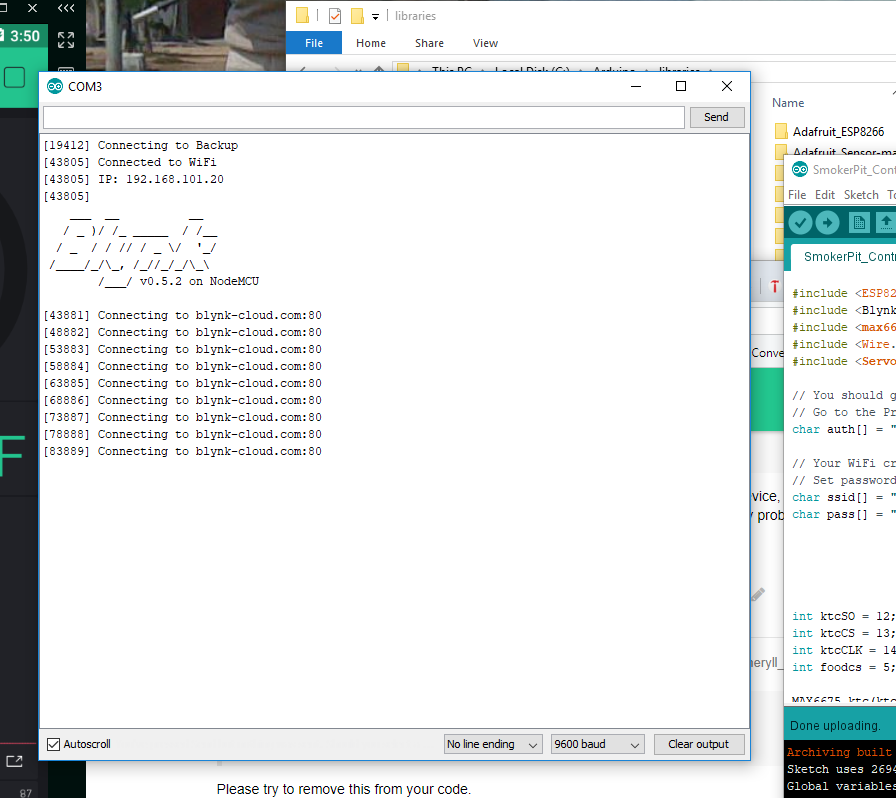SSH IoT Device Behind Firewall - Remote Access Made Simple
Have you ever wanted to check in on a small smart device, perhaps a tiny computer like a Raspberry Pi, that is sitting quietly somewhere, maybe at a remote location or even just across town? It is a common wish for many folks who use these clever gadgets. These devices, often called IoT devices, do many helpful things, from keeping an eye on things to making everyday tasks easier. But, they often sit behind a kind of digital barrier, like a home router or a company firewall, which makes reaching them from far away seem like a real puzzle.
That digital barrier, often called a NAT router or a firewall, is there to keep your local network safe. It acts like a one-way door, letting things go out to the internet but usually stopping anything from coming in unless you specifically tell it to. This setup is good for security, yet it does make it tough when you want to connect back to your own small device, perhaps an ssh iot device behind firewall, to give it instructions or see how it is doing. It is a bit like trying to talk to someone inside a house when all the doors are locked from the outside.
Good news, though: there are some clever ways to get around this challenge. You can, for instance, set up a special kind of connection that goes right through these barriers, making it feel as if your device is sitting right next to you on your home network. This piece will walk you through how you can achieve this, making it simple to manage your devices from anywhere, without needing to be a computer wizard, you know.
- Amanda Anka
- Shae Mccombs Married
- Luis Marcel Barrios Jr Dad
- Are Sean Lew And Kaycee Rice Still Friends
- Evonitz Wife
Table of Contents
- Getting Your IoT Devices Online - Even When They're Hidden
- Why is Remote Access for your SSH IoT Device Behind Firewall a Big Deal?
- How Does Connecting to an SSH IoT Device Behind Firewall Really Work?
- What Are Some Ways to Reach Your SSH IoT Device Behind Firewall?
- Using SocketXP for Your SSH IoT Device Behind Firewall
- Other Smart Ways to Connect to an SSH IoT Device Behind Firewall
- Keeping Your SSH IoT Device Behind Firewall Safe - What's Important?
- Real-World Use Cases for Your SSH IoT Device Behind Firewall
Getting Your IoT Devices Online - Even When They're Hidden
Many people find themselves with a small computer, like a Raspberry Pi, or another smart gadget that they want to access from a distance. Perhaps it is a home automation hub, a sensor monitoring something far away, or even a tiny server. The common issue is that these devices are often tucked away behind a router or a company's protective barrier, which makes direct communication from the outside world quite difficult. This barrier, a firewall, or a NAT router, is there for a good reason: to keep unwanted visitors out of your private network. It is like a security guard for your digital home, only letting approved traffic pass through. However, this also means that when you want to initiate a connection from outside to your ssh iot device behind firewall, the guard typically says no, you know.
The problem is that a NAT router, for instance, often gives many devices on a home network a shared public internet address. This means that from the outside, all your devices look like one big address. If someone tries to connect to that address, the router does not know which specific device inside your network they want to reach. It is a bit like having an apartment building with one main door, and if someone knocks, the doorman does not know which apartment they are trying to visit. This setup prevents incoming connections from starting unless you set up very particular rules. But, we can still find ways to make those connections happen, which is very useful.
Why is Remote Access for your SSH IoT Device Behind Firewall a Big Deal?
Think about all the cool things small smart devices do these days. They help automate homes, make factories run smoother, and even assist with scientific projects. They offer a lot of helpful automation, make things more efficient, and bring much convenience to our lives. But, if you leave these devices without anyone watching them, they can become weak points for security problems. This is where being able to reach them from a distance becomes a truly big deal. For instance, if you have a device that is supposed to be collecting data in a faraway spot, you do not want to drive there every time you need to check on it or make a small change. Remote access saves time and effort, you see.
When you have many of these devices, perhaps hundreds or even thousands, scattered across different places, managing them without remote access would be nearly impossible. Imagine a company that uses many Raspberry Pis or other small Linux computers in its industrial setup. Being able to control these devices from a central office, sending them commands or even larger tasks, is absolutely important for keeping things running smoothly. It is not just about convenience; it is about making sure operations continue without interruption and that you can fix problems quickly, too. This ability to connect to an ssh iot device behind firewall from anywhere gives you incredible control and flexibility.
How Does Connecting to an SSH IoT Device Behind Firewall Really Work?
So, if a firewall or router usually stops incoming connections, how do you get around that to reach your ssh iot device behind firewall? The trick involves making the device itself start a connection to a server on the public internet. Think of it this way: instead of you knocking on the device's door, the device calls you. Once the device has made this outgoing call, it creates a special pathway, a kind of secure link, that you can then use to send information back to it. This pathway is like a secret handshake that allows you to communicate as if the device were sitting right there on your local home network. It is a clever way to bypass the usual barriers without opening up your entire network to the internet, which is rather good for security.
This method means you do not have to go looking for your device's specific internet address, which can change sometimes, or mess with your router's settings. All the data you send back and forth through this special pathway is wrapped up very securely, so it stays private. This approach makes it much simpler for anyone, even those who are not tech experts, to manage their small devices. It allows you to send commands, or even bigger sets of instructions, from a simple web page, all without needing to figure out complex network details. It is about creating a safe and easy way to stay connected to your smart gadgets, you know.
The Magic of Secure Tunnels for SSH IoT Device Behind Firewall
The core idea behind reaching an ssh iot device behind firewall is setting up something called a reverse tunnel. This tunnel is a secure link that goes from your device, through your firewall and router, and out to a service on the internet. It is like your device digging a tunnel from its location to a public meeting point. Once this tunnel is open, you can then use that same tunnel to connect back to your device. This connection can be for things like SSH, which lets you send text commands, or even for graphical interfaces like VNC or RDP, which let you see and control the device's screen remotely. It is a very versatile way to get to your devices.
One common way this magic happens is through services that specialize in creating these secure pathways. For instance, some services use secure SSL/TLS connections, which are the same kind of connections that keep your online banking safe. These services build a kind of secure tube through your firewall and router, across the internet, and directly to your small devices. This means that all the information going through this tube is protected, keeping your remote access private and secure. It is a neat trick that makes remote control much more straightforward, you see.
What Are Some Ways to Reach Your SSH IoT Device Behind Firewall?
There are several ways to make this connection happen, and each has its own benefits. One very common and effective way is to use something called reverse SSH tunnels. This means your small device starts an SSH connection to a server that is out on the public internet. Once that connection is made, you can then use that same connection, but in reverse, to get to your device. It is like opening a two-way street where before there was only a one-way path out. This method is quite good because SSH itself is a secure way to communicate, so your connection is protected from the start, you know.
Another popular option involves using VPN solutions. VPN stands for Virtual Private Network, and it creates a secure, private connection over a public network, like the internet. Tools like WireGuard or OpenVPN can help set this up. With a VPN, it is like creating a private, encrypted road directly from your computer to your device, no matter where it is located. This makes your device appear as if it is part of your local network, even when it is far away. These methods are particularly helpful when you need a very secure and always-on connection to your ssh iot device behind firewall.
Using SocketXP for Your SSH IoT Device Behind Firewall
One service that helps with this kind of remote access is SocketXP. This platform is designed to make it simple to connect to your smart devices, even when they are hidden behind network barriers. SocketXP creates those secure tunnels, often called reverse proxy tunnels, that go through your firewall and router and over the internet to your devices. This means you can get to your devices using SSH, or even other remote control tools like VNC and RDP, without needing to change any complex settings on your home router or firewall. It really simplifies the whole process, you know.
With SocketXP, you can connect to a Raspberry Pi or any other small Linux device from anywhere, just as if it were right there on your local network. It even lets you send commands and bigger sets of tasks to your device from a web page, which is very convenient for managing many devices. The service takes care of wrapping all your data in a secure way, so you do not have to worry about the safety of your connection. It is a way to get direct control of your ssh iot device behind firewall without the usual headaches that come with remote access, you see.
Other Smart Ways to Connect to an SSH IoT Device Behind Firewall
Beyond SocketXP, there are other services and techniques that can help you reach your devices. Some services, like Ngrok or remote.it, also offer similar tunneling capabilities. They create a public address for your device, allowing you to connect to it from anywhere on the internet, all while your device stays safely behind its firewall. These services handle the tricky parts of setting up the connection, making it easier for you to focus on what you want your device to do. They are particularly useful for quick setups or when you need to share access temporarily, you know.
For those who like to build their own solutions, learning about how to set up reverse SSH tunnels manually can be quite rewarding. This often involves having a public server that acts as a middleman. Your device connects to this server, and then you connect to the same server, telling it to forward your connection to your device. It is a bit more involved to set up, but it gives you full control. For example, setting up remote access via SSH on Ubuntu for your ssh iot device behind firewall is a smart move, offering many good points in terms of how safe your setup is and how easy it is to look after. These methods show that there is more than one way to solve the puzzle of remote access.
Keeping Your SSH IoT Device Behind Firewall Safe - What's Important?
While gaining remote access to your devices is very helpful, making sure those connections are safe is just as important. When you open a pathway to your ssh iot device behind firewall, you want to make sure only authorized people can use it. One of the simplest yet most effective steps is to set up a firewall on the device itself. This acts as an extra layer of protection, controlling what kind of network traffic is allowed to reach your device. It is like having a second security guard at the door, checking IDs, you know.
Another very important safety measure is to use SSH keys instead of passwords for logging in. Passwords can sometimes be guessed or cracked, but SSH keys are much, much harder to break. They involve a pair of digital keys: one stays on your computer, and the other goes on your device. When you try to connect, these keys talk to each other to confirm your identity. It is a much stronger way to prove who you are. Also, always keep your device's software updated. Updates often fix security holes that bad actors could try to use. Regular updates are like giving your device a fresh coat of armor, keeping it strong against new threats, you see.
Real-World Use Cases for Your SSH IoT Device Behind Firewall
Smart devices are everywhere these days, and many interesting projects are running great software and doing wonderful things all over the globe. Think about a smart farm where sensors collect data on soil moisture and temperature. An ssh iot device behind firewall can send this data to a central system, and farmers can connect to it remotely to adjust irrigation or check on crop health without being physically present. This saves a lot of time and makes farming more efficient. It is a very practical application of remote access, you know.
In industrial settings, managing thousands of Raspberry Pis or other small Linux systems is a common need. These devices might be controlling machinery, monitoring production lines, or collecting data from various sensors. Being able to send commands or batch jobs to these devices from a central web portal, without needing to go to each device individually, is absolutely critical for smooth operations and quick problem-solving. This kind of remote control makes it possible to oversee large-scale operations with fewer people on site, which can be a huge benefit for businesses, you see. Secure tunneling, using methods like MQTT to send access tokens and then WebSockets for the SSH connection, helps make this kind of remote management possible, even with services like AWS IoT providing managed tunnels for your devices.
- William Abadie Partner
- Brandon Boyd
- How Old Is Paula Deen
- Luis Marcel Barrios Jr Dad
- Are Sean Lew And Kaycee Rice Still Friends

Can't connect to blynk-cloud.com:80 - Solved - Blynk Community

Download XShell 8.0.0063 for Windows - Filehippo.com

Download Xshell for Windows 11, 10, 7, 8/8.1 (64 bit/32 bit)